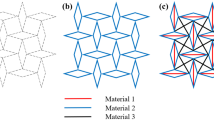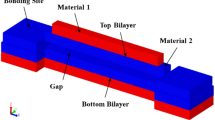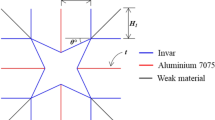Abstract
Negative thermal expansion (NTE) and negative Poisson’s ratio (NPR) are counterintuitive material properties that have gained popularity as the focus of many recent works. However, most of the structures previously studied only exhibit NTE or NPR exclusively. One important structure that has already been shown to exhibit NPR is the re-entrant triangle. In this work, the property of NTE in re-entrant triangular cellular structure composed of welded/bonded/brazed ribs of two different materials is investigated via analytical and finite element (FE) modelling. Based on analytical and FE analysis, the geometrical and material parameters for attaining NTE in the re-entrant metamaterial are established. The analysis and simulations reveal the dependence of NTE on the inclination of the longer chevron strut, the dimensionless rod coefficient of thermal expansion (CTE), the ratio of thermal expansion coefficients of constituent struts but independent of scale and temperature. The extent of this property becomes more negative for higher values of the angle of the longer chevron strut with the vertical, higher ratios of CTE of the base to chevron strut material and for lower values of the non-dimensional re-entrant base material thermal expansion coefficient. The anisotropic and NTE behaviour is stretch-dominated. Effectively, combined with previous knowledge of NPR in the re-entrant triangle, NTE leads to further significance of such structures for many thermal and mechanical applications, such as composite materials, sensors and electronic components industries in both thermal and mechanical applications.
















Similar content being viewed by others
Abbreviations
- NTE:
-
Negative thermal expansion
- CTE:
-
Coefficient of thermal expansion
- NPR:
-
Negative Poisson's ratio
- a :
-
Unit cell height
- b :
-
Unit cell width
- h :
-
Height of internal re-entrant ribs
- \( \frac{a}{b} \) :
-
Unit cell aspect ratio
- θ 1 :
-
Inclination of re-entrant base struts with vertical
- θ 2 :
-
Inclination of longer chevron struts with vertical
- α n ; n = {1, 2}:
-
CTE of material n
- α X :
-
Cell CTE along the X-axis
- α Y :
-
Cell CTE along the Y-axis
- \( \frac{{E_{1} }}{{E_{2} }} \) :
-
Cell stiffness ratio
- E n ; n = {1, 2}:
-
Young’s modulus of material n
- ΔT :
-
Change in temperature
- Δa :
-
Change in unit cell height
- Δb :
-
Change in unit cell width
References
Khosrovani N, Sleight AW (1999) Strong anisotropic thermal expansion in oxides. Int J Inorg Mater 1(1):3–10
Lind C (2012) Two decades of negative thermal expansion research: Where do we stand? Materials 5(6):1125–1154
Wang L et al (2015) Metal fluorides, a new family of negative thermal expansion materials. J Materiomics 1(2):106–112
Takenaka K (2012) Negative thermal expansion materials: technological key for control of thermal expansion. Sci Technol Adv Mater 13(1). doi:10.1088/1468-6996/13/1/013001
Krokidas PG, Nikolakis V, Burganos VN (2012) Heating and sorption effects on silicalite-1 unit cell size and geometry. Microporous Mesoporous Mater 155:65–70
Tao JZ, Sleight AW (2003) The role of rigid unit modes in negative thermal expansion. J Solid State Chem 173(2):442–448
Sleight AW (1998) Isotropic negative thermal expansion. Annu Rev Mater Sci 28(1):29–43
Barrera GD et al (2005) Negative thermal expansion. J Phys Condens Matter 17:R217–R52
Miller W et al (2009) Negative thermal expansion: a review. J Mater Sci 44(20):5441–5451. doi:10.1007/s10853-009-3692-4
Pryde AKA et al (1997) Rigid unit modes and the negative thermal expansion in ZrW2O8. Phase Transit 61(1–4):141–153
Bieniok A, Hammonds KD (1998) Rigid unit modes and the phase transition and structural distortions of zeolite rho. Microporous Mesoporous Mater 25(1–3):193–200
Heine V, Welche PRL, Dove MT (1999) Geometrical origin and theory of negative thermal expansion in framework structures. J Am Ceram Soc 82(7):1793–1802
Grima JN et al (2015) Maximizing negative thermal expansion via rigid unit modes: a geometry-based approach. Proc R Soc A 471(2179). doi:10.1098/rspa.2015.0188
Wang L et al (2014) Negative thermal expansion in TiF3 from the first-principles prediction. Phys Lett A 378(38–39):2906–2909
Sigmund O, Torquato S (1997) Design of materials with extreme thermal expansion using a three phase topology optimization method. J Mech Phys Solids 45(6):1037–1067
Vandeperre L, Howlett A, Clegg WJ (2002) Application of negative thermal expansion to optical fibers. In: CIMTEC 2002: international conferences on modern materials and technologies, 2002, Florence
Vandeperre LJ, Clegg WJ (2003) Tailoring strains through microstructural design. In: 2003 MRS proceedings, vol 785
Lakes R (2007) Cellular solids with tunable positive or negative thermal expansion of unbounded magnitude. Appl Phys Lett 90:221905-1–221905-3
Saxena KK, Das R, Calius EP (2016) Three decades of auxetics research—materials with negative Poisson’s ratio: a review. Adv Eng Mater. doi:10.1002/adem.201600053
Grima JN, Zammit V, Gatt R (2006) Negative thermal expansion. Xjenza 11:17–29
Grima JN et al (2007) A system with adjustable positive or negative thermal expansion. Proc R Soc Lond A 463(2082):1585–1596
Grima JN et al (2007) Connected triangles exhibiting negative Poisson’s ratios and negative thermal expansion. J Phys Soc Jpn 76(2):025001
Lim T-C (2012) Negative thermal expansion structures constructed from positive thermal expansion trusses. J Mater Sci 47(1):368–373. doi:10.1007/s10853-011-5806-z
Lim TC (2013) Negative thermal expansion in transversely isotropic space frame trusses. Phys Status Solidi B 250(10):2062–2069
Wei K et al (2016) Planar lattices with tailorable coefficient of thermal expansion and high stiffness based on dual-material triangle unit. J Mech Phys Solids 86:173–191
Ha CS et al (2015) Controllable thermal expansion of large magnitude in chiral negative Poisson’s ratio lattices. Phys Status Solidi B 252(7):1431–1434
Wu L, Li B, Zhou J (2015) Isotropic negative thermal expansion metamaterials. arXiv:1509.07889. Accessed 25 Oct 2016
Lim TC (2005) Anisotropic and negative thermal expansion behavior in a cellular microstructure. J Mater Sci 40(12):3275–3277. doi:10.1007/s10853-005-2700-6
Larsen UD, Sigmund O, Bouwstra S (1996) Design and fabrication of compliant micromechanisms and structures with negative Poisson’s ratio. In: Micro electro mechanical systems, 1996, MEMS’96, proceedings. An investigation of micro structures, sensors, actuators, machines and systems. The ninth annual international workshop. IEEE, New York
Sigmund O, Torquato S (1996) Composites with extremal thermal expansion coefficients. Appl Phys Lett 69:3203–3205
Collins EG, Richter S (1995) Linear-quadratic-Gaussian-based controller design for Hubble Space Telescope. J Guid Control Dyn 18(2):208–213
Chen J et al (2013) Effectively control negative thermal expansion of single-phase ferroelectrics of PbTiO3-(Bi, La)FeO3 over a giant range. Sci Rep 3:2458. doi:10.1038/srep02458
Shen X et al (2013) Large negative thermal expansion of a polymer driven by a submolecular conformational change. Nat Chem 5:1035–1041
Author information
Authors and Affiliations
Corresponding author
Ethics declarations
Conflicts of Interest
The authors hereby declare no conflicts of interest.
Rights and permissions
About this article
Cite this article
Ng, C.K., Saxena, K.K., Das, R. et al. On the anisotropic and negative thermal expansion from dual-material re-entrant-type cellular metamaterials. J Mater Sci 52, 899–912 (2017). https://doi.org/10.1007/s10853-016-0385-7
Received:
Accepted:
Published:
Issue Date:
DOI: https://doi.org/10.1007/s10853-016-0385-7




